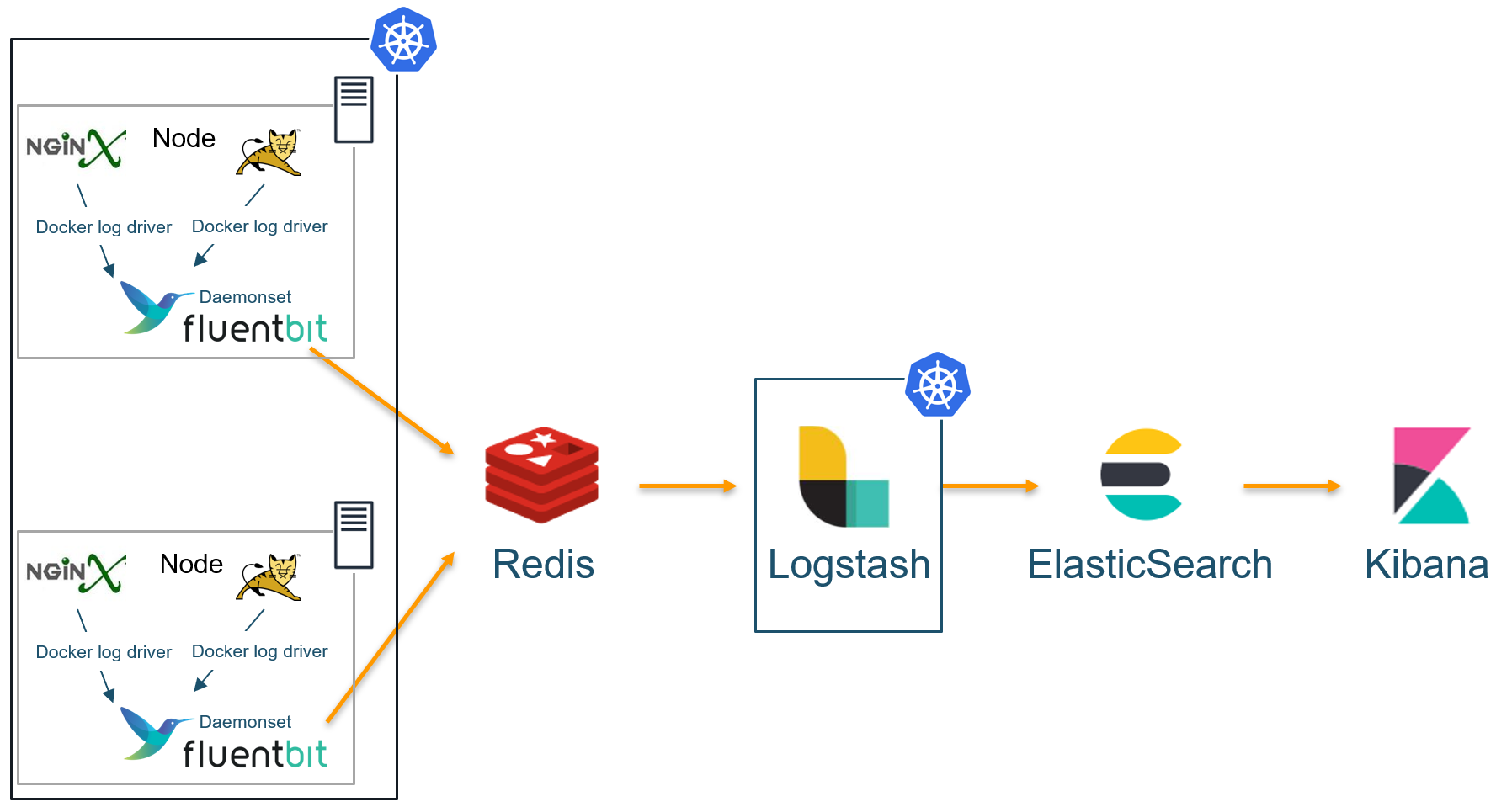Kubernetes搭建ELK + FluentBit + Redis(缓冲队列)
雪域幽狐 2020-05-29 13:30 阅读:11784
ELK作为日志系统的套装,广受喜爱。在日志采集部分,有Logstash、FileBeat、Fluentd、FluentBit等,各有自己的特点。
如果日志采集器收集的日志直接输出到日志解析器,在日志解析器负载较高时,会拖住日志采集器,因此建议在日志采集器和日志解析器中加一个缓冲队列。
本文以FluentBit为日志采集器、Redis为缓冲队列、Logstash为日志解析器为例,在Kubernetes集群下的搭建。

Redis、ElasticSearch、Kibana的搭建请参见相关文章,本文不再赘述。
如果日志采集器收集的日志直接输出到日志解析器,在日志解析器负载较高时,会拖住日志采集器,因此建议在日志采集器和日志解析器中加一个缓冲队列。
本文以FluentBit为日志采集器、Redis为缓冲队列、Logstash为日志解析器为例,在Kubernetes集群下的搭建。

Redis、ElasticSearch、Kibana的搭建请参见相关文章,本文不再赘述。
1、部署FluentBit
cat <<EoF > fluent-bit-go-redis.yaml apiVersion: v1 kind: ServiceAccount metadata: name: fluent-bit --- apiVersion: rbac.authorization.k8s.io/v1beta1 kind: ClusterRole metadata: name: pod-log-reader rules: - apiGroups: [""] resources: - namespaces - pods verbs: ["get", "list", "watch"] --- apiVersion: rbac.authorization.k8s.io/v1beta1 kind: ClusterRoleBinding metadata: name: pod-log-crb roleRef: apiGroup: rbac.authorization.k8s.io kind: ClusterRole name: pod-log-reader subjects: - kind: ServiceAccount name: fluent-bit namespace: default --- apiVersion: v1 kind: ConfigMap metadata: name: fluent-bit-config labels: app.kubernetes.io/name: fluentbit data: fluent-bit.conf: | [SERVICE] Parsers_File parsers.conf [INPUT] Name tail Tag kube.* Path /var/log/containers/*.log Exclude_Path /var/log/containers/fluentbit*.log,/var/log/containers/logstash*.log Parser docker DB /var/log/flb_kube.db Mem_Buf_Limit 5MB Skip_Long_Lines On Refresh_Interval 10 [FILTER] Name parser Match * Parser nginx Key_Name log [OUTPUT] Name redis Match * UseTLS false TLSSkipVerify true Hosts redisserver:6379 DB 0 Key logstash parsers.conf: | [PARSER] Name nginx Format regex Regex ^(?<remote>[^ ]*) (?<host>[^ ]*) (?<user>[^ ]*) \[(?<time>[^\]]*)\] "(?<method>\S+)(?: +(?<path>[^\"]*?)(?: +\S*)?)?" (?<code>[^ ]*) (?<size>[^ ]*)(?: "(?<referer>[^\"]*)" "(?<agent>[^\"]*)")? \"-\"$ Time_Key time Time_Format %d/%b/%Y:%H:%M:%S %z [PARSER] Name docker Format json Time_Key time Time_Format %Y-%m-%dT%H:%M:%S.%L Time_Keep On # Command | Decoder | Field | Optional Action # =============|==================|================= Decode_Field_As escaped log --- apiVersion: apps/v1 kind: DaemonSet metadata: name: fluentbit labels: app.kubernetes.io/name: fluentbit spec: selector: matchLabels: name: fluentbit template: metadata: labels: name: fluentbit spec: serviceAccountName: fluent-bit containers: - name: fluent-bit-go-redis image: majst01/fluent-bit-go-redis-output volumeMounts: - name: varlog mountPath: /var/log - name: varlibdockercontainers mountPath: /var/lib/docker/containers readOnly: true - name: fluent-bit-config mountPath: /fluent-bit/etc/ - name: mnt mountPath: /mnt readOnly: true resources: limits: memory: 500Mi requests: cpu: 500m memory: 100Mi volumes: - name: varlog hostPath: path: /var/log - name: varlibdockercontainers hostPath: path: /var/lib/docker/containers - name: fluent-bit-config configMap: name: fluent-bit-config - name: mnt hostPath: path: /mnt EoF修改60行的Redis地址,然后再部署。
kubectl apply -f fluent-bit-go-redis.yaml2、检查Redis中的日志
用Redis客户端连上服务器,在配置的DB中,可以看到对应日志,否则使用kubectl logs ds/fluentbit进行排查。能看到日志即可进入下有一步。3、部署Logstash
用于从Redis获取日志,然后输出到ElasticSearch。cat <<EoF > logstash.yaml
apiVersion: v1
kind: ConfigMap
metadata:
name: logstash-config
labels:
app.kubernetes.io/name: logstash
data:
logstash.conf: |
input {
redis {
host => "redisserver"
db => "0"
data_type => "list"
key => "logstash"
}
}
filter {
grok {
match => { "message" => "%{COMBINEDAPACHELOG}"}
}
}
output {
elasticsearch {
hosts => ["ElasticSearchServer:9200"]
index => "nginx-log-%{+YYYY.MM}"
}
}
---
apiVersion: apps/v1
kind: Deployment
metadata:
name: logstash
labels:
app.kubernetes.io/name: logstash
spec:
selector:
matchLabels:
name: logstash
template:
metadata:
labels:
name: logstash
spec:
containers:
- name: logstash
image: logstash:6.8.8
volumeMounts:
- name: logstash-config
mountPath: /usr/share/logstash/pipeline/
volumes:
- name: logstash-config
configMap:
name: logstash-config
EoF修改第11行的redis地址和第26行的ElasticSearch地址。注意:第11行的redis地址不要带端口号,第26行的ElasticSearch需要带端口号,如果是默认https端口,需要加上443。然后执行kubectl apply -f logstash.yaml4、在ElasticSearch/Kibana中查看日志
前一步运行正常,即可在ElasticSearch/Kibana中看到日志,否则使用kubectl logs查看pod日志。0条评论
登陆后可评论